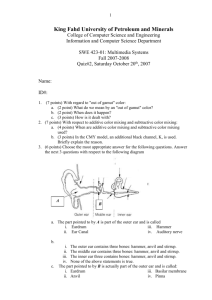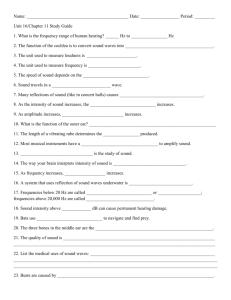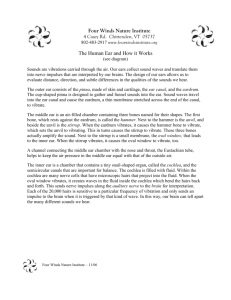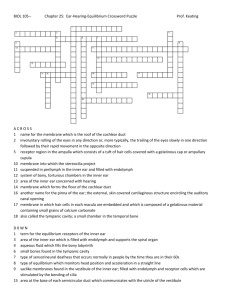MTH2111: College Algebra
advertisement
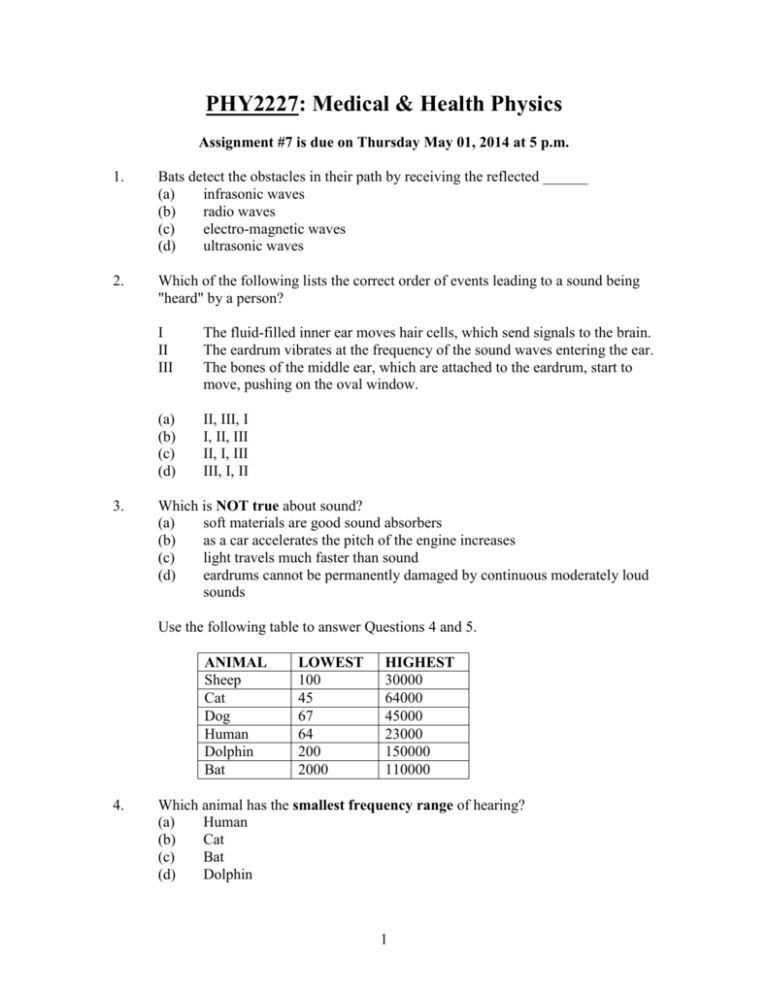
PHY2227: Medical & Health Physics Assignment #7 is due on Thursday May 01, 2014 at 5 p.m. 1. Bats detect the obstacles in their path by receiving the reflected ______ (a) infrasonic waves (b) radio waves (c) electro-magnetic waves (d) ultrasonic waves 2. Which of the following lists the correct order of events leading to a sound being "heard" by a person? 3. I II III The fluid-filled inner ear moves hair cells, which send signals to the brain. The eardrum vibrates at the frequency of the sound waves entering the ear. The bones of the middle ear, which are attached to the eardrum, start to move, pushing on the oval window. (a) (b) (c) (d) II, III, I I, II, III II, I, III III, I, II Which is NOT true about sound? (a) soft materials are good sound absorbers (b) as a car accelerates the pitch of the engine increases (c) light travels much faster than sound (d) eardrums cannot be permanently damaged by continuous moderately loud sounds Use the following table to answer Questions 4 and 5. ANIMAL Sheep Cat Dog Human Dolphin Bat 4. LOWEST 100 45 67 64 200 2000 HIGHEST 30000 64000 45000 23000 150000 110000 Which animal has the smallest frequency range of hearing? (a) Human (b) Cat (c) Bat (d) Dolphin 1 5. Which animal has the largest frequency range of hearing? (a) Human (b) Cat (c) Bat (d) Dolphin The following graph represents the Sound Level safety Limits. Use it to answer Questions 6 to 8. 6. What is the maximum sound level in decibels, you should be exposed to for 6 hours? (a) 92 dB (b) 93 dB (c) 95 dB (d) 97 dB 7. If you are exposed to a maximum sound level of 100 decibels, what is exposure time in hours? (a) 2 hours (b) 4 hours (c) 6 hours (d) 8 hours 8. What is the maximum safe time you should be exposed to a sound level of 95dB? (a) 4½ hours (b) 4¼ hours (c) 4 hours (d) 3¾ hours 2 9. The frequency which is not audible to the human ear is: (a) 50 Hz (b) 500 Hz (c) 5000 Hz (d) 50000 Hz 10. The vibrations or the pressure variations inside the inner ear are converted into electrical signals by the_________ (a) Cochlea (b) Tympanic (c) Pinna (d) Anvil 11. Vibrations inside the ear are amplified by the three bones namely the _________ in the middle ear. (a) hammer, anvil and stirrup (b) hammer, anvil and pinna (c) hammer, cochlea and stirrup (d) auditory bone, anvil and stirrup 12. The membrane that separates the outer ear from the middle ear of mammals is called the (a) basilar membrane (b) tympanic membrane (c) oval window (d) tectorial membrane 13. Compared with chemical stimuli, auditory stimuli (a) travel farther (b) travel more quickly (c) provide better directional information (d) all of the above 14. The Eustachian tube connects the (a) outer ear and middle ear (b) middle ear and inner ear (c) inner ear and throat (d) middle ear and throat 15. Which of the following sensory receptors function via hyperpolarization rather than depolarization? (a) rod and cone cells (b) organs of Corti (c) proprioceptors (d) all of the above 3 16. Which of the following is not one of the ossicles in the middle ear of humans? (a) Stirrup (b) Anvil (c) Saddle (d) Hammer 17. In the cochlea, the hair cells are contained by the (a) tectorial membrane (b) tympanic membrane (c) basilar membrane (d) vestibular membrane 18. The human inner ear is where sound waves are amplified by means of the vibrations of tiny bones. (a) True (b) False SECTION B Answer Question 17 OR Question 18 17. 18. (a) With reference to the structure of the ear, explain how it: (i) responds to an incoming sound wave. (ii) adjusts to very loud sound; (ii) adjusts to very quiet sounds. (b) The ear is said to have a logarithmic response to intensity. (i) Explain what this expression means; (ii) Calculate the intensity level of a sound of intensity 5.1 x 10–5Wm–2 given that the threshold intensity is 1.00 x 10–5Wm–2. (c) When people are suffering from a cold they often experience discomfort in their ears in an aircraft. Explain why this occurs and what they could do to help reduce the pain. (d) To ensure that someone can hear a conversation you raise your voice by 15dB. Determine the change in sound intensity. (a) Describe the three main parts of the ear and explain their contributions to the process of hearing. (b) There are two common causes of hearing loss in adults. Explain what these two types are and suggest whether a hearing aid can help these problems. 4 (c) A cyclist and a railway train are approaching each other. The cyclist is moving at 50ms–2 and the train at 30ms–2. If the train sounds a warning siren at a frequency of 500Hz, calculate the frequency of the note heard by the cyclist: (i) before, and (ii) after the train has passed by. (Assume the speed of sound in air = 340ms–2.) (d) A sound of intensity 10–6Wm–2 corresponds to normal conversation. Calculate the sound level in decibels by assuming that the threshold of hearing is 10–12Wm–2. 5
